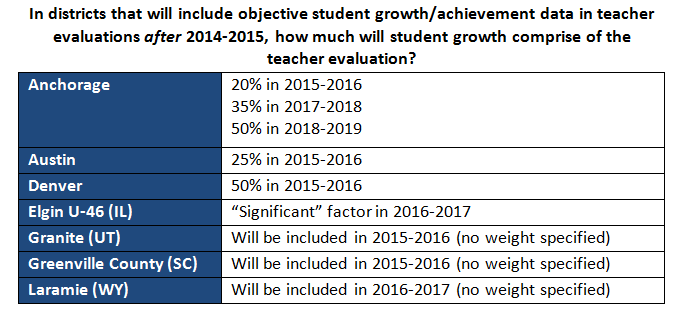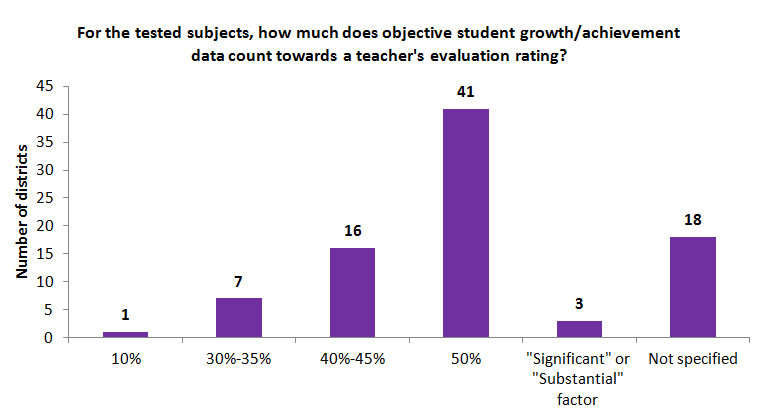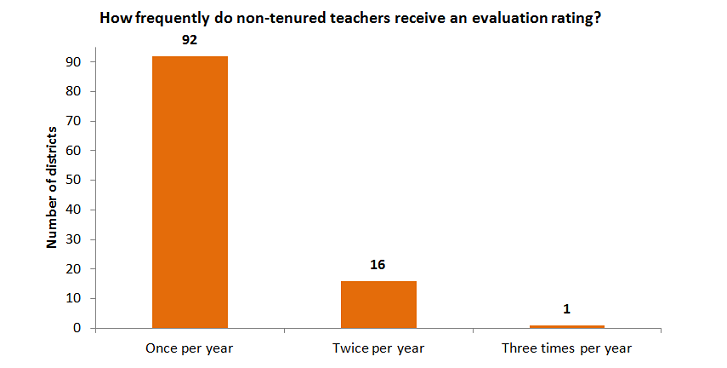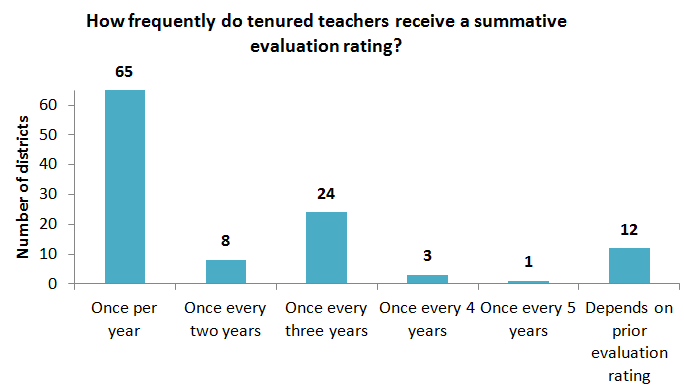March 2015: Teacher evaluations
District Trendline, previously known as Teacher Trendline, provides actionable research to improve district personnel policies that will strengthen the teacher workforce. Want evidence-based guidance on policies and practices that will enhance your ability to recruit, develop, and retain great teachers delivered right to your inbox each month? Subscribe here.
For this month’s Trendline, we closely examine teacher evaluation policies in the largest
districts across the country. Specifically, we take a look at the major
components within evaluations, frequency and teachers’ ability to grieve their evaluation
ratings.
Evaluation components
Evidence of student growth
or achievement
Perhaps the most debated
component of teacher evaluations is whether to factor in any evidence of
student learning based on objective student achievement data. The vast majority
of districts, approximately 72 percent, use some kind of measure of student growth
or student achievement data in some part to determine a teacher’s evaluation
rating.
While most of the districts
in our database do include evidence of student learning within teacher
evaluations, it’s important to note that they do so in a variety of ways, not
just through value-added measures. Most districts measure student learning
through various measures, like scores on standardized assessments, student
learning objectives (SLOs) and other growth goals.
Over a quarter of large
districts in the Teacher Contract Database (28 percent) still do not include such measures in
teacher evaluations, despite a flurry of state and federal policies the past
few years moving districts in this direction. This number should come down in a
few years as a number of districts have explicitly stated this year that they plan
to include such data in teacher evaluations in future years: Anchorage, Austin, Denver, Elgin U-46
(IL), Granite (UT), Greenville
County (SC) and Laramie (WY).


While 86 districts currently
include student growth or achievement data in teacher evaluations, these
districts do not all incorporate this measure in the same way. Nearly half (48
percent) have established that 50 percent of the overall evaluation is measured
by student growth/achievement data for tested subjects (usually math and
reading). Another 21 percent of these districts do not give a specific weight
to how much student growth/achievement data will count in the total evaluation.

How are districts dealing
with teachers in non-tested subjects? When we take a look at whether or not
student growth/achievement is considered in teacher evaluations for teachers in
non-tested subjects, we find that 75 percent of large districts do use
objective measures of student learning in evaluations assessing teachers of
non-tested subjects.
Peer review and student
input
When it comes to other
components of teacher evaluations—peer review and student input—we find more
variety in how districts do or don’t incorporate these measures.

With peer review and student
input, many districts make it a choice individual schools can choose to
include.
Peer review, however, is a
much more widely used measure in teacher evaluations than student input. Almost
half of our districts either require peer review or allow it as an option. Just
a third of districts require or allow student input.
Evaluation frequency
In the vast majority of
districts, nearly 77 percent, non-tenured or beginning teachers are evaluated
once per year. One district—Clark County
(NV)—is an outlier, formally
evaluating non-tenured teachers three times per year.

Eleven
districts are not included in the chart above, including six Florida districts
(Broward
County, Lee County, Miami-Dade, Palm Beach, Pinellas
County and Polk County) and Oakland, where teachers in their first year are evaluated two
times per year and annually thereafter. In Orange
County (FL), the district
evaluates beginning teachers even more frequently, with evaluations twice a
year for teachers in their first through third years of teaching, and annual
evaluations thereafter.
Columbus
(OH), Greenville
County (SC) and St. Paul also have distinctive evaluation policies. In Columbus, first-year teachers are
evaluated once. Thereafter, the frequency
of their evaluation is based on their performance. In Greenville,
first-year teachers receive only informal feedback about their practice and are
not formally evaluated. In St. Paul,
first-year teachers are evaluated three times per year; second- and third-year
teachers are evaluated twice per year.
While
non-tenured or beginning teachers tend to be evaluated more frequently, tenured
teachers are almost always evaluated less frequently.

While over half of the
districts evaluate tenured teachers annually, nearly a quarter of districts (23
percent) formally evaluate teachers at most once every three years.
Not included above are five California districts, (Fresno, Long Beach, Los Angeles, Sacramento and San Diego), where teachers are initially evaluated once every
two years, until they gain 10 years of experience, after which they are
evaluated only once every five years.
Grievances
After the evaluation rating
is assigned, teachers can, in some districts, grieve the rating under certain
circumstances even if there are no previous procedural violations in how the
evaluation was carried out.

Over two-thirds of large districts
(42 districts) allow teachers to grieve or formally appeal their evaluation
rating even if there are no procedural violations that took place. Of those
districts, seven (Billings
(MT), Los Angeles, Milwaukee, Montgomery
County (MD), Polk County (FL), Prince
William County (VA) and Richmond
(VA)) only allow a formal appeal
or grievance to be filed if the teacher in question received one of the lowest
evaluation ratings.
From just last year, we’ve
found districts have changed or clarified many aspects of their evaluation
systems and in the years ahead, we expect this trend to continue; so check back
on our Teacher Trendline often to read about those changes, or run your own
report on teacher evaluation policies in the Teacher Contract Database to see for yourself.
More like this

Districts are facing hard choices: How can teacher evaluation help?

Rural teacher evaluation system shows promising results for students struggling in math

Put me in, coach! How practice plus coaching helps aspiring teachers win

